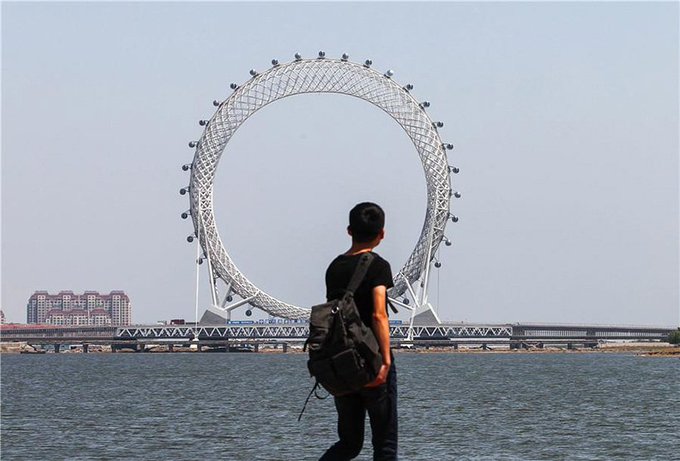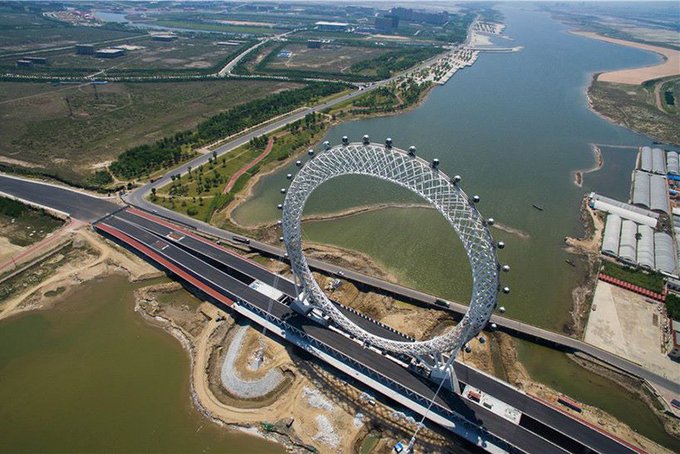Weirdest Megaprojects In History

May 27, 2025
•19 min read
Here are the weirdest-looking megaprojects in history!
There really is no limit to what mankind can build! But while some engineering efforts have given us record breaking skyscrapers and huge tunnels, others have produced some truly mind-blowing megaprojects. From telescope’s with mirrors the size of a basketball court, to structures that can melt diamonds in less than a second, and even cities encased in underground domes! Let's explore some of the strangest and most fascinating megaprojects in history.
The Dubai Frame
Dubai’s iconic skyline is a snapshot of some of the world’s tallest skyscrapers, and since the erection of the Dubai Frame, the horizon is picture perfect, literally. At 492 ft tall, this flawless picture frame transports visitors 48 floors up, providing a sky-high view of the city from its 305 ft interior viewing bridge. But as simplistic as its rectangular shape seems, its construction required a lot of heavy lifting.
More than 350,000 cubic ft of reinforced concrete was poured into its foundations and towering pillars, alongside 2,000 tons of steel, and more than 31,000 square feet of laminated glass. That’s enough glass to cover more than half a standard football field! With the final cost of this super-sized structure reaching an eyewatering $43.6 million, you could say Dubai were investing in the big picture. Although, there’s a lot of drama surrounding its seemingly simple design. The project was conceived by architect Fernando Donis, who submitted the frame’s design as part of a competition hosted by Dubai’s government back in 2008. While Fernando won the competition, along with a tasty cash prize of $100,000, he never received a contract or compensation for the use of his design as promised in the competition rules. So, Fernando levied a hefty intellectual property lawsuit against Dubai’s government! However, Dubai’s legal system gives the government sovereign immunity against any and all lawsuits. That means you can’t sue the government of Dubai unless it gives you permission to sue it. It looks like this mega project is turning out to be a mega pain in the butt for Fernando.The Pont Jacques-Chaban-Delmas
Drawbridges are absolutely mesmerizing! There’s just something about watching the lifting sections of the bridge, called bascules, slowly raise up to let river traffic, from tiny boats to huge cruise ships, pass through.
However, you can’t deny that most drawbridges rely on old-fashioned mechanics, from the days where pullies and counterweights raised and lowered each individual bridge section. This amazing megastructure, on the other hand, is the phenomenal future of lifting bridges!Stiletto Church
In the Asian nation of Taiwan, Christianity is a minority religion that makes up just 3.9% of the population’s preferred prayers. It’s so small that the nation barely boasts any significant Christian sites, with one very big, very blue, and very weird exception.
While the phenomenal 55 ft high, 36 ft wide stiletto structure below may look like a supersized Cinderella fantasy, it’s actually a church!Slovak Radio Building
The Slovakian capital of Bratislava has embraced the free market economy in recent years, but its brief stint under a socialist regime left a monumental mark on the city. The strange remnant that is the Slovak Radio Building stands out in the north of the city like a sore, socialist thumb.
China’s Quarry Hotel
China is the home of some seriously innovative megaprojects; like the world’s largest air purifier, their trillion-dollar water diversion scheme, and even their huge horizontal skyscraper. But there’s one project that has really hit new heights, or, more accurately, depths!
Back in the 1950’s, the Shenkeng Quarry was just one of many mining operations surrounding Shanghai. However, once the resources dried up, the pit was simply abandoned and left to collect rainwater. But in 2006, a pioneering plan was proposed to transform the huge hole, which was less than 30 miles from the bustling city of Shanghai, into a one-of-a-kind hotel! Instead of building around the pit, the hotel would be anchored inside it, with some sections completely submerged beneath the water. While the idea looked stunning on paper, building entire floors underwater was a supremely difficult task. Over 2 million cubic ft of concrete, which is more than 22 Olympic swimming pools, were required to create the substructure alone. But pumping all the concrete down that 295 ft drop to the quarry’s bottom caused the mixture to separate.The Beijing Watercube
The Chinese capital of Beijing is home to some of the most impressive, modern megastructures on the planet. But right in the middle of this innovative city is a building that really stands out! Though it looks like a big box filled with building sized bubbles, this is actually China’s National Aquatics Center, though it’s known more simply as the Beijing Watercube.
It sits next to the famous, and equally attention-grabbing, Bird’s Nest Stadium, which you might remember from the 2008 Olympics. When China was elected this Olympics’ host city in 2001, they wasted no time or expense constructing a variety of brand-new sporting facilities. And while the Birds Nest was their main feature, the Watercube received the same star treatment!Thirty Meter Telescope
Reflecting telescopes are, arguably, some of the most important pieces of scientific equipment ever invented by man. They work by using a combination of curved, convex mirrors that reflect light back to a focal point, which forms a close-up image of something far away. And the bigger those convex mirrors are, the greater the light-gathering power is, and the further out into the heavens the telescope can see!
Unfortunately, convex mirrors increase drastically in price the larger they get because of the sheer amount of work, time, and specialist equipment they take to get perfect. But just how expensive? Well, the world’s largest single, convex mirror made to date measures in at a colossal 13.7 ft across, weighs 3.5 tons, and cost more than a mammoth $20 million! Fortunately, in 1992, the first computer controlled segmented mirror was designed for use in Hawaii’s Keck Observatories. Using 36 adjoining mirror segments, engineers created a 33 ft wide mirror, housed in a huge white dome 13,600 ft up the Maua Kea mountainside! At these remote altitudes, the telescope’s images are less affected by atmospheric interference and light pollution. But, like the stars, science never sleeps. In 2000, scientists proposed making a 30 meter, or nearly 100 ft wide, mirror for a brand-new mountainside telescope! This insane venture would require 492 separate segments, bringing the mirror’s overall size to a staggering 7050 square ft! That’s almost the same size as a standard basketball court.Alem Center's Indoor Ferris Wheel
Turkmenistan is home to some of the most unusually star-obsessed megaprojects in the world. Like the octagonal-star shaped Wedding Palace, which is an 11-story registry office. Or Turkmenistan’s TV Tower, a communication center which has the world's largest architectural image of a star built into it.
This is because the eight-point starburst is a historic symbol of Islam, one which Turkmenistan embodies in its country’s emblem. But as weird and wonderful as the buildings that incorporate the image look, none come close to the star-struck strangeness that is Turkmenistan’s Alem center. From the front, this 312 ft high building seems to subtly contain just one eight-pointed star, but from above, the very ground it’s built on incorporates many more! Although that’s not the strangest thing about it. What do you think is inside this perplexingly circular building? Is it a giant spotlight? Or does it house the world’s biggest clock face? Well, it actually houses the world’s largest indoor Ferris wheel. At 156 ft high, it cost approximately $90 million to build and encapsulate in this insanely ostentatious structure. But for all the delightful, star-spangled views, a ride all the way up has a few unpleasant surprises.The Bailang River Bridge Ferris Wheel
China’s Weifang City is a bustling hub of life perched on top of the historic Bailang river. But it’s not the beautiful river that draws the tourists to the bridge as much as the giant metal eye perched on top of it. Built onto the base of the Bailang bridge, the Bailang River Bridge Ferris Wheel is impossible to miss.
the world’s largest #spokeless #ferrisWheel opens in shandong, #china ! More detail : designboom.com/technology/bai…
The Guangzhou Circle
But when it comes to circular structures, China has more weird and wonderful megaprojects to offer than just a physics-defying Ferris wheel! If you take a look along the banks of the Pearl River in Guangdong, you’ll see a gigantic, golden, circular skyscraper!
At 452 ft tall, making it 1.5 times the height of the statue of liberty, the aptly named Guangzhou Circle is the world’s tallest circular building. Built around two corresponding concrete elevator pillars, a latticed steel structure was designed to hold the golden façade in place.The Mir Mine Eco City
Back in 1955, in a part of Siberia that even Siberians consider remote, soviet geologists made a small discovery. But today, that discovery has turned into one of the largest excavations the world has ever seen! This is the marvelous Mir mine, one of the largest diamond mines on earth, with a pit 1,722 ft deep and 3,900 ft in diameter.
That’s so deep that you could stack 75 standard mining dump trucks from the bottom of this thing to the top! Or, if you were to put the Empire State Building at the bottom, it would be more than 250 ft away from reaching the top! In its heyday, back in the 1960’s, this profitable pit produced 10,000 carats of kimberlite diamond, which is about 2 tons worth! But after the mine ran dry in 2001 it was shut down, having produced around $17.82 billion worth of diamonds in its lifetime!
The Mirny Mine in Siberia. So fucking huge some architects want to build an eco city inside it.
The National Ignition Facility
From the outside, the building below may not look like much, but it contains a megaproject that, quite literally, defies physics.
Future Hadron Collider
Buried 328 ft beneath the French and Swiss countryside lies one of the most unbelievably complex machines ever created. This is the inside of the Large Hadron Collider, or LHC for short, which stretches a staggering 17 miles in circumference underground, making it the world’s largest particle accelerator.
For those of us who slept through one too many science lessons, a particle accelerator is a machine that fires elementary particles, such as electrons or protons, to super high energies. How high? In the LHC’s case, two particle beams travel at almost the speed of light before they are made to collide. So, they could make that 17-mile trip in less than a millisecond! You can’t even blink that fast! They reach these speeds thanks to the ring of superconducting magnets which line the 17-mile structure, which are cooled to a frosty -271.3 degrees to increase their magnetic field. That’s colder than space! A colossal 1624 of these magnets, some of which measure up to a gargantuan 50 ft in length, bend and focus the particle beams. All while accelerating structures dotted around the ring boost the energy of the particles on their way! And when these two beams collide, the huge amount of energy from their impact is jammed into such a small vacuum of space that it explodes and creates mass in the form of subatomic particles. Like a miniature big bang!


































